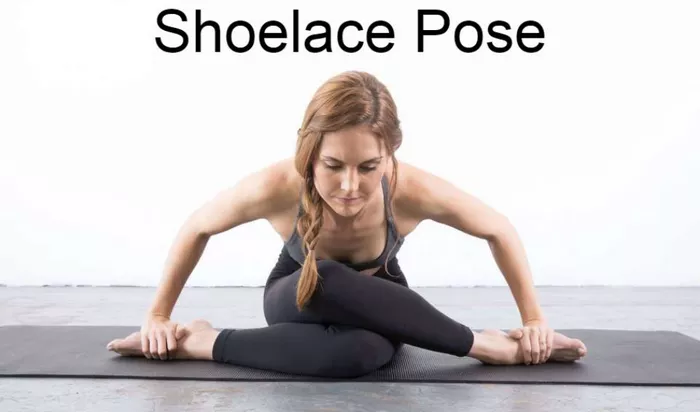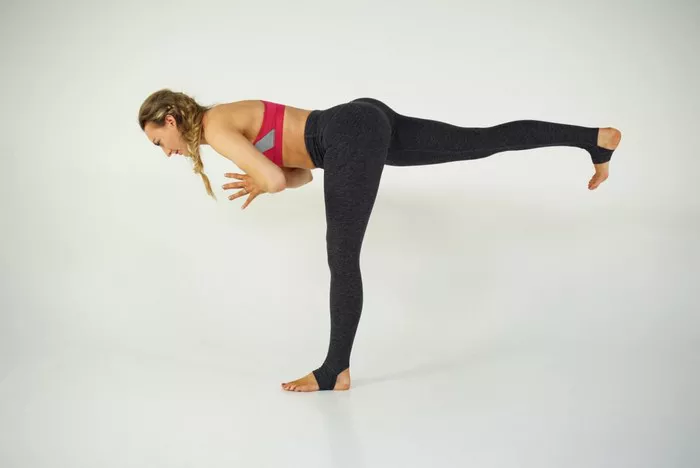Yoga is an ancient practice that encompasses physical, mental, and spiritual well-being. Among its myriad poses, Shoelace Pose, also known as Agnistambhasana in Sanskrit, stands out for its unique blend of stretching, balance, and relaxation. In this article, we delve into the origins, symbolism, benefits, variations, modifications, step-by-step instructions, as well as precautions and contraindications of Shoelace Pose.
Origins and Symbolism
Shoelace Pose finds its roots in Hatha Yoga, a branch of yoga that focuses on physical postures to balance mind and body. The name “Shoelace Pose” is derived from the shape the legs take, resembling the cross-legged position one might adopt while tying shoelaces. In Sanskrit, “Agnistambhasana” is a combination of two words: “Agni,” meaning fire, and “Stambha,” meaning pillar or support. This name signifies the strength and stability cultivated in the pose, akin to a steady flame burning within.
Symbolically, Shoelace Pose represents the union of opposites and the balance between effort and surrender. As the legs intertwine like the laces of a shoe, practitioners are encouraged to find harmony between the masculine and feminine energies within themselves. Additionally, the grounded nature of the pose symbolizes stability and rootedness, while the forward fold encourages introspection and surrender.
See Also: Bird of Paradise Pose (Svarga Dvijasana)
Physical and Mental Benefits
Shoelace Pose offers a plethora of physical and mental benefits, making it a valuable addition to any yoga practice:
1. Hip Opening: The primary benefit of Shoelace Pose is its ability to stretch and open the hips, particularly the outer hips and glutes. This can help alleviate tension and tightness accumulated from prolonged sitting or physical activity.
2. Improved Flexibility: Regular practice of Shoelace Pose can increase flexibility in the hips, knees, and ankles, enhancing overall mobility and range of motion.
3. Spinal Alignment: The forward fold aspect of Shoelace Pose helps lengthen the spine and relieve compression, promoting better posture and spinal health.
4. Stress Relief: The gentle pressure applied to the hips and lower back in Shoelace Pose can release stored tension and stress, inducing a sense of calm and relaxation.
5. Balanced Energy Flow: By stimulating the second chakra (Svadhisthana) located in the pelvis, Shoelace Pose can help balance the flow of energy in the body, promoting emotional stability and creativity.
In addition to these physical benefits, Shoelace Pose also offers mental benefits such as improved focus, concentration, and emotional resilience.
Variations and Modifications
Like many yoga poses, Shoelace Pose can be modified and adapted to suit individual needs and abilities. Here are some variations and modifications:
1. Half Shoelace Pose: For practitioners with limited flexibility or mobility, Half Shoelace Pose is an accessible alternative. Simply stack one knee on top of the other, keeping the bottom leg extended.
2. Seated Shoelace Pose: This variation is performed in a seated position, making it ideal for those who find it uncomfortable to sit on the floor. Sit on a yoga block or cushion to elevate the hips if needed.
3. Supported Shoelace Pose: Place a bolster or folded blanket under the torso to provide support and alleviate pressure on the hips and knees.
4. Bound Shoelace Pose: For advanced practitioners looking to deepen the stretch, interlace the fingers behind the back and fold forward, allowing the arms to lift overhead.
These variations cater to practitioners of all levels, ensuring that everyone can experience the benefits of Shoelace Pose regardless of their physical limitations.
Step-by-Step Instructions
Follow these step-by-step instructions to practice Shoelace Pose safely and effectively:
1. Begin in a seated position on the mat with your legs extended in front of you.
2. Bend your right knee and cross it over the left thigh, bringing the right foot towards the outside of the left hip.
3. Flex both feet to protect the ankles and knees.
4. If possible, stack the right knee directly on top of the left knee, aligning the shins as much as possible.
5. Sit evenly on both sitting bones, ensuring that your weight is distributed evenly.
6. Lengthen through the spine, lifting the crown of the head towards the ceiling.
7. Optionally, you can stay in this upright position or gently hinge forward from the hips, keeping the spine long.
8. Hold the pose for 5-10 breaths, focusing on deep, steady breathing.
9. To release, gently unwind the legs and switch sides, crossing the left knee over the right thigh.
10. Repeat the pose on the opposite side, maintaining symmetry in the body.
Precautions and Contraindications
While Shoelace Pose offers numerous benefits, it may not be suitable for everyone. Consider the following precautions and contraindications before practicing:
1. Knee or Hip Injuries: Individuals with knee or hip injuries should approach Shoelace Pose with caution or avoid it altogether. If practicing with an injury, modify the pose or seek guidance from a qualified yoga instructor.
2. Pregnancy: Pregnant individuals should avoid deep hip-opening poses like Shoelace Pose, especially in the later stages of pregnancy. Instead, opt for prenatal yoga poses that are safe and supportive for both mother and baby.
3. Low Back Pain: If you experience low back pain, take care not to force the forward fold in Shoelace Pose. Listen to your body and only go as far as feels comfortable, using props for support if needed.
4. Recent Surgery: If you have undergone recent surgery, particularly in the hips or knees, consult with your healthcare provider before attempting Shoelace Pose. It’s essential to allow adequate time for healing and rehabilitation before engaging in intense physical activity.
5. Osteoarthritis: Individuals with osteoarthritis or other degenerative joint conditions may find Shoelace Pose uncomfortable or exacerbating. Modify the pose as needed and prioritize comfort and stability over depth of stretch.
As with any yoga practice, it’s essential to approach Shoelace Pose mindfully, honoring your body’s limitations and avoiding any movements that cause pain or discomfort.
Conclusion
In conclusion, Shoelace Pose is a versatile yoga posture that offers a multitude of benefits for the body, mind, and spirit. By exploring its origins, symbolism, benefits, variations, modifications, step-by-step instructions, as well as precautions and contraindications, practitioners can deepen their understanding and appreciation of this ancient asana. Whether you’re seeking to improve flexibility, relieve stress, or find inner balance, Shoelace Pose invites you to explore the union of opposites and discover the harmony within.






















